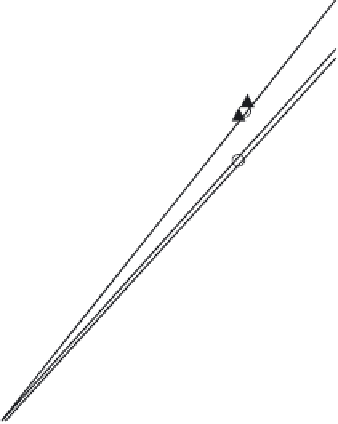Environmental Engineering Reference
In-Depth Information
Rupture Length
General
Surface rupture length along a fault varies greatly; in California earthquakes it has been gen-
erally in the range of 1 to 40 mi. The crustal deformation that occurred during the Alaskan
event of 1964 was the most extensive yet studied in a single earthquake (Bolt et al., 1975).
Vertical displacements occurred along the Alaskan coastline for a distance of almost 600 mi,
including a broad zone of subsidence of as much as 6 ft along the Kodiak-Kenai-Chugach
mountain ranges, and a major zone of uplift of as much as 35 ft along the coastline. The large
extent is perhaps the reason for the unusual duration of 3 min. During the 1906 San
Francisco event, the San Andreas Fault is estimated to have ruptured for a length of 260 mi.
Rupture Length vs. Magnitude
The energy released by a shallow-focus earthquake has been related to the surface length
of fault rupture as shown in
Figure 11.27.
The majority of events plotted are from the west-
ern United States, Alaska, and northern Mexico; and may not apply elsewhere, although
good agreement has been found at the higher magnitudes with quakes in Turkey and
Chile. Such relationships as given in the figure have been used to estimate the potential
magnitude of an earthquake by assuming that a fault will rupture along its entire identi-
fied length, or perhaps only one half to one third of its length, depending on its activity
and the degree of risk involved.
For a specific fault, the
M
w
of a potential earthquake can be estimated by relating it to
the potential rupture length of the fault in the western United States (NRC, 1997) using the
Wells and Coppersmith (1994) relationship
M
w
a
b
log (SRL)
(11.18)
Mi/
Km/
1000
800
600
Explanation
type of displacement
Strike slip
Normal slip
400
600
200
400
200
Normal oblique-slip
Reverse slip
Reverse oblique-slip
100
80
100
80
60
40
60
40
20
20
10
San Fernando, 1971
8
10
8
FIGURE 11.27
Scatter diagram of length of surface faulting
related to earthquake magnitude from
historical events of surface faulting
throughout the world. Lines are least
squares fits. (From Taylor, C.L. and Cluff,
L.S., Proceedings of ASCE, The Current State
of knowledge of Lifeline Earthquake
Engineering, Specialty Conference,
University of California, Los Angeles, 1977,
pp. 338-353. With permission.)
6
4
Strike slip
(North America
and world)
6
4
Oroville, 1975
All fault types (North America)
2
All fault types
(world)
2
1
0.8
1
2
3
4
5
Earthquake magnitude
6
7
8
9





































































